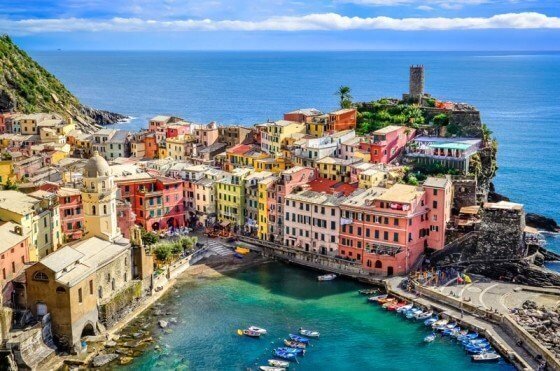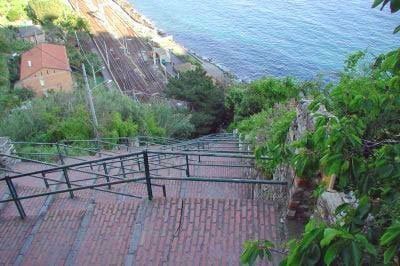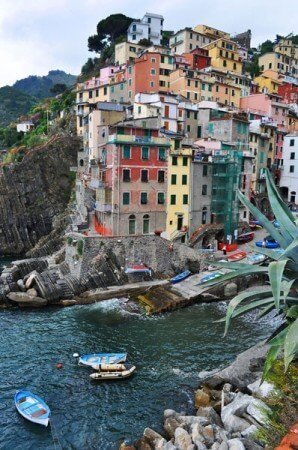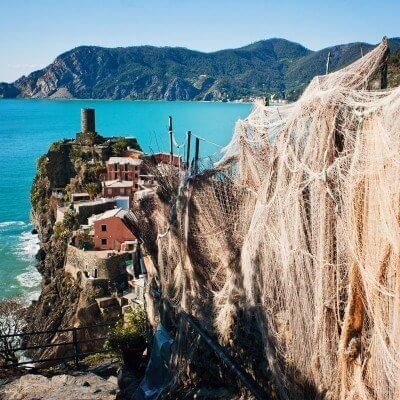
This is the third in a four-part series: You can read the entire journal from the beginning here.
For me, the best way to figure out an Italian train schedule is to go online, pull up ItaliaRail, and check the listings. Otherwise, I end up confused and spend six hours going north just to end up one hour east. Even so, I still occasionally have a “wrong train adventure.” Such was the case on my trip to Monterosso. Normally, you can get there from Modena in about two and a half hours, but my journey took two train changes, and I arrived an hour after the train that had left an hour after mine. Don’t ask me to explain—just know that I’ve now been to Fidenza and Sarzana. I couldn’t tell you exactly where they are, but they looked like places I wouldn’t mind returning to.
Schedules can be maddening: some trains pass straight through your intended stop without pausing. When I caught a local train from Monterosso to Corniglia, I actually saw my destination through the window as we sped past—then had to backtrack on another train half an hour later. To make things more exciting, stations aren’t always announced, so you have to watch the signs carefully and be ready to leap off. Great fun.

Cinque Terre—literally “Five Lands”—is made up of Monterosso, Vernazza, Corniglia, Manarola, and Riomaggiore, strung like jewels along the Italian Riviera. No cars are allowed in the towns; you travel by train, boat, or on your own two feet. Many visitors come to hike the trails, which are spectacular: sheer drop-offs, terraced hillsides, and unspoiled views of the Mediterranean. Most routes take about 90 minutes from town to town. Once you arrive, there’s not much to do except sit in the sun, hike, drink the local wines, eat, and make friends with the locals. These towns used to be a hidden treasure, but guidebooks have blown their cover, and in summer they’re overrun with tourists. In November, though, most shops and hotels are shuttered, leaving the towns largely to the locals—and, luckily for me, to a stray traveler or two.
At the Corniglia station, visitors face a daunting climb: 365 steps to reach the town. I’d hoped to stay at Da Cecio, a place friends had recommended, but it was closed for the season. Instead, I rented a room from a local family for about $68 USD, perched on a cliff with a view of the entire bay. That evening, the family pulled me into an enoteca packed with locals. Once again, I was treated like I belonged, downing anchovies, octopus, and the inevitable pesto, washed down with plenty of wine. The most common question I got was, “What on earth are you doing here in November?” I shrugged and answered, “Sono uno stupido americano.” That always got a laugh. I stumbled home later that night, stuffed with food and wine, surprised I hadn’t fallen off a cliff.

The next morning, after breakfast, I stopped at San Pietro, the Gothic church built in 1334 that sits right by the station. It’s worth a visit whether you’re arriving or departing.
From there, I hiked southeast to Manarola, a small fishing and wine town. Here, the local wine, sciacchetrà, is everywhere—sweet, very sweet. One glass wasn’t enough for me to judge, so I tried three. Still sweet, but warming, especially with bread and cheese. After wandering the narrow streets and visiting the 700-year-old church of San Lorenzo, perched high above the town with its frescoes and stained glass, I set off again. The views were breathtaking, and I was told the church bells ring out over the cliffs every morning at 7.
I continued along the Via dell’Amore, the “Path of Love,” an easy, romantic trail clinging to the cliffs. The sun was low, shadows long, and it was impossible to take a bad photograph. After an hour’s walk, I arrived in Riomaggiore, where I would spend the night.
Riomaggiore is the most “modern” of the five towns, with newer residences mixed among the old. High above loom the ruins of a 15th-century castle. The main streets felt overpriced and touristy, so I took a steep side road and soon found myself in another local enoteca. The entire room turned to look at me as I came in, but a group of four waved me over and squeezed me into their booth. They ordered on my behalf—trofie al pesto, pasta made with chestnut flour, and yes, more anchovies. Afterward, though I’d only had one glass of wine, I still managed to get lost in Riomaggiore’s endless stairways before finding my hostel. If you like hiking, this is the village to linger in—trails climb into the mountains with spectacular views, though some are treacherous. If hiking isn’t your thing, head to Bar il Giardino. It may be a bit touristy, but the view over the Ligurian Sea is worth it. Order salt cod or anchovies, sip wine, and watch the waves.

On my last day in Cinque Terre, I caught the milk train back to Vernazza. Much of the short journey runs through dark tunnels, so a flashlight isn’t a bad idea. Every so often, the train bursts into sunlight, revealing staggering views of the turquoise Mediterranean.
Vernazza is my favorite of the five towns. If you imagine a classic Italian fishing village of fifty years ago, this is it: a picturesque harbor with small boats pulled onto the beach, a cluster of colorful houses climbing the hillsides, and the Doria Castle with its dark watchtower perched on cliffs built to guard against pirates. A stone spiral staircase takes you to the top, where the waves crash far below.
As in the other towns, the streets are cobblestoned, the hills terraced with olive groves, and the shops glow golden in the morning light. With so many olives grown here, it’s no surprise that pesto was invented in Vernazza. From town, it’s an easy train ride to anywhere in Italy, but I lingered for one last afternoon: a minerally Vino delle Cinque Terre with bread and cheese for lunch. I even broke my rule against buying things while traveling and tucked a bottle of local olive oil into my backpack—something to bring back memories on a gray Portland afternoon.